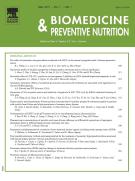Thyroidectomy induced hepatic toxicity and possible amelioration by Ginkgo biloba leaf extract - 13/08/14

 , Areej J.M. Alghabban a, Heba Abou Harga c
, Areej J.M. Alghabban a, Heba Abou Harga cAbstract |
The liver is a major target organ for thyroid hormone action and marked changes occur in liver functions in the case of hypo- or hyperthyroidism. This studied aimed at inverstigating the biochemical and histopathological changes in the liver after thyroidectomy and the ameliorating role of Ginkgo biloba leaf extract (GLE). A total of 50 male albino rats were equally divided into five groups; 1st to 3rd groups were control, sham operated and GLE groups while 4th group was thyroidectomized rat group and 5th group was treated thyrodectomized rat with GLE. Serum T3 and T4 levels after 3weeks of thyroidectomy was significantly decreased when compared with the control group, while TSH significantly increased when compared with the control group increased. Serum ALT, AST, ALP and GGT showed significant (P<0.05) increase in thyroidectomized group when compared with control, sham operated and sham operated with GLE groups. On the one hand, treatment of thyroidectomized rats with GLE improved this increase in serum ALT, AST, ALP and GGT in thyroidectomized rat group. Liver sections of thyroidectomy group showed marked positive reaction and increase number of PCNA staining of hepatocyte nuclei. On the other hand, liver in treated of thyroidectomized rat with GLE group showed a marked reduction in the number of PCNA-positive nuclei when compared with sections in thyroidectomy group. Treatment of thyroidectomized rat with GLE improves the biochemical, histopathological and immunohistochemical alternations and the intensity of PCNA immunoreactive cells demonstrating the recovery of some injury.
Le texte complet de cet article est disponible en PDF.Keywords : Thyroidectomy, Liver, Toxicity, Histopathology, PCNA immunoreactivity, Rat
Plan
Vol 4 - N° 3
P. 391-397 - juillet 2014 Retour au numéroBienvenue sur EM-consulte, la référence des professionnels de santé.
L’accès au texte intégral de cet article nécessite un abonnement.
Déjà abonné à cette revue ?

